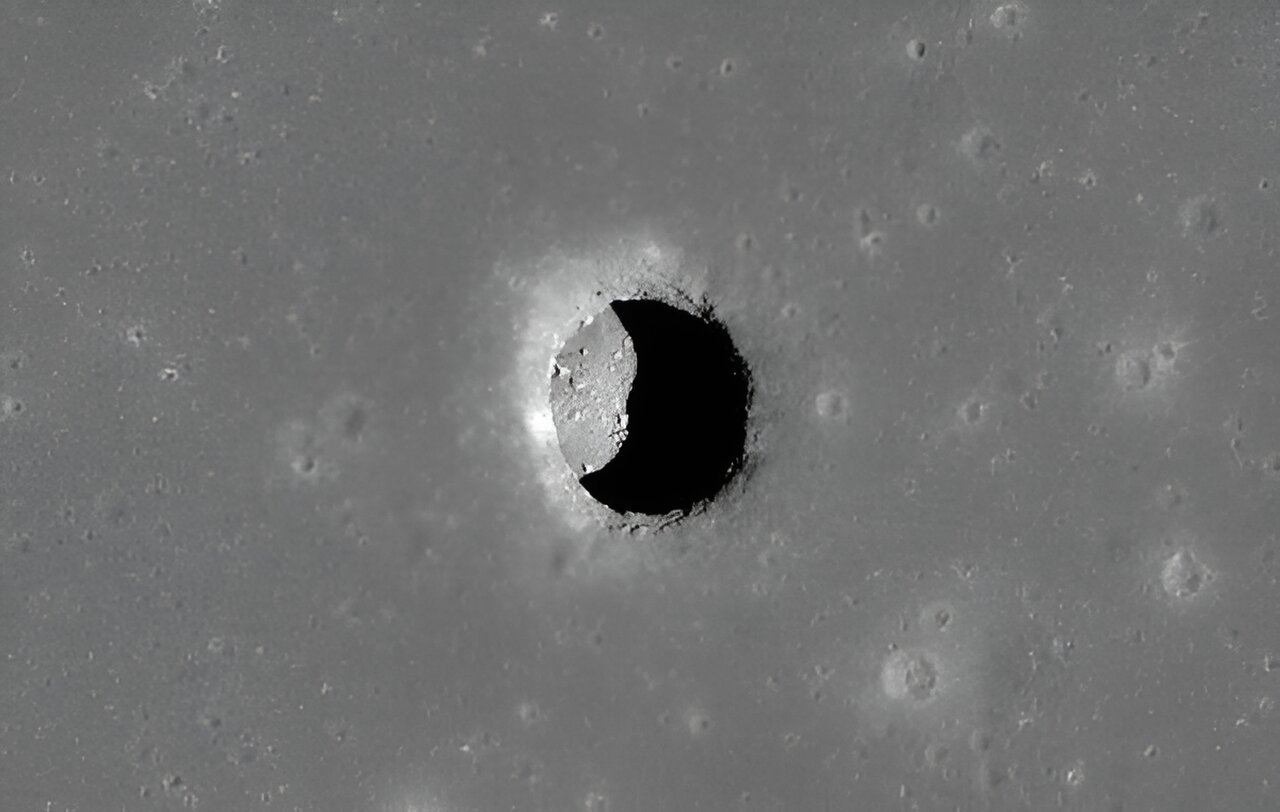The pit in Mare Tranquillitatis leads to an underground cave system. Credit: NASA
Using radar, a NASA spacecraft, the Lunar Reconnaissance Orbiter (LRO), has confirmed the existence of caves beneath the lunar surface. Here’s why such geological features will be key to establishing a base on the Moon, and what they can tell us about the common cosmological origins of Earth and our Moon.
Lunar-orbiting satellites first detected craters on the Moon’s surface decades ago. Many of these were thought to be vents connected to substantial underground tunnels formed through volcanic processes, but only now has this been confirmed through analysis of radar data.
Some of the tunnels thought to exist on the Moon are expected to be lava tubes, which are also found on Earth. When molten lava flows from the ground, the lava flow eventually cools and solidifies into a crust. The lava inside is still molten and continues to flow. After the lava has flowed away, it leaves an empty tunnel called a lava tube. These formation processes are thought to be very similar on Earth and the Moon.
The data used in the latest study were collected in 2010 by LRO, but only recently analyzed using the latest signal processing techniques. Radar (12.6 cm wavelength electromagnetic waves) fired at acute angles to these lunar craters partially illuminated shadowy subsurface areas to generate measurable radar echo signals.
The timing and amplitude of the reflected signals allowed the researchers to compare the simulations and create a picture of the underground terrain. Records show that the largest sinkhole “Mare Tranquillitatis” leads to a cave 80 meters long and 45 meters wide: an area equal to about half a football field.
It is likely that the lunar surface is home to hundreds of such caves. It is widely thought that about 4.5 billion years ago, a young Earth violently collided with a Mars-sized proto-planet, splitting our young planet into the Earth and Moon system we have today.
After this high-energy impact, the moon may have melted. It is therefore not surprising that caves of apparently volcanic origin, which bear a striking resemblance to volcanic caves here on Earth, are present on the Moon. However, we don’t need to worry about astronauts dealing with the dangers of a volcanic eruption; Volcanic activity on the Moon completely died out about 50 million years ago.
A home from home?
On Earth, we live in an extremely random environment that protects us from threats from outer space. For example, Jupiter, the largest planet in our solar system, is well placed to gravitationally pull asteroids away from Earth. This minimizes the frequency of cataclysmic asteroid collisions with our planet—like the one that marked the end of the dinosaurs.
A less obvious threat to life on Earth is ionizing radiation. The entire solar system is constantly bathed in a soup of charged particles called galactic cosmic rays, which are accelerated to great speeds by distant supernova explosions, sending them on a collision course with Earth.
In addition, periodic events called coronal mass ejections from our sun hurl highly energetic particles in our direction in much greater numbers, but on a less frequent basis.
The Earth’s magnetic field shields us from this radiation to a large extent, directing the charged particles toward the north and south poles. This is the origin of the aurora borealis and australis that light up the night sky at high latitudes. Earth’s thick atmosphere also protects us, but we still get some exposure: a transatlantic return flight, where we are higher in the atmosphere, gives the traveler a dose of radiation equivalent to five X-ray scans.
Now spare a thought for our moon, which possesses neither an atmosphere nor a visible magnetic field. Far from being a “sea of calm” (named after the site of the first human landing on the Moon in 1969), the lunar surface is constantly bombarded by high-energy radiation.
This presents a serious challenge to populating a lunar base with people. Astronauts jumping on the lunar surface will absorb about 10 times more radiation than we experience on a transatlantic flight and about 200 times more than we receive on Earth’s surface.
Although our bodies can cope with the generally harmless low levels of background radiation we experience on Earth, exposure to high levels of ionizing radiation can have serious health consequences. When ionizing radiation interacts with the body, it can ionize atoms inside cells, stripping them of electrons. This damage can sometimes prevent proper DNA replication and in extreme cases can cause cell death.
For these reasons, any lunar base must provide adequate radiation shielding to protect its inhabitants. However, radiation protection is best provided by dense material, which is expensive to transport to the Moon from Earth.
Therefore, naturally protected areas, such as the recently discovered caves, are being designated as potential sites for human habitation on the Moon. These caves would provide its inhabitants with a large rock shield of 130 to 170 meters, sufficient to stop even the highest energy radiation.
Provided by The Conversation
This article is republished from The Conversation under a Creative Commons license. Read the original article.![]()
citation: What lunar caves tell us about the common origin of the Earth and the Moon (2024, July 25) retrieved July 25, 2024 from https://phys.org/news/2024-07-lunar-caves-earth-moon.html
This document is subject to copyright. Except for any fair agreement for study or private research purposes, no part may be reproduced without written permission. The content is provided for informational purposes only.
